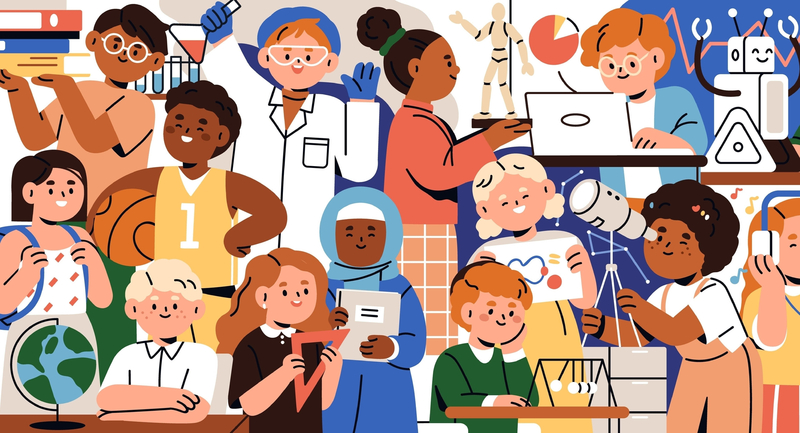Describing personalized learning for someone who hasn't experienced it can be difficult. We all have our own memories and perceptions about education; consequently, well-designed environments that place the learner at the center can sound utopian. Yet, tens of thousands of students who attend schools that participate in the Institute for Personalized Learning network, an organization with which we are involved, experience this powerful way of learning every day.
Here we describe a student's typical day at a personalized learning school. The setting is the Waukesha STEM Academy-Saratoga Campus in Waukesha, Wisconsin. The Academy, a charter school, opened in 2010 and serves 336 students in grades 6–8.
Before sharing what a day at the Waukesha STEM Academy looks like, let's clarify what we mean by personalized learning. Many definitions have been attached to this term, and confusion abounds. In our definition, personalized learning does the following:
- Nurtures powerful learners rather than just proficient students.
- Positions learners as partners with educators to identify learning goals, design learning paths, create learning experiences, and share accountability for learning progress and success.
- Is competency-based, in that progress is based on learning rather than on time spent in learning activities. Students share in monitoring growth in their competencies and progress along learning continuums, often across multiple subject areas.
Adjusting to Self-Directed Learning
Let's meet Cal. He's a real student, and he's typical of thousands of students today who are learning in redesigned, learning-centered environments.
His previous school felt fine to Cal. He would wake up each morning and know exactly what he was going to do that day. In fact, his planner, which looked similar to those of the other 27 students in his class, told him everything he needed to know: Math: Page 122; solve problems 2–18 (evens). Science: Read chapter 2 and then answer the questions about trees and birds in complete sentences. Spelling: Study for final test on Friday. Reading and Writing: Read the story on pages 210–218 and compare how the main character is like you and how he is different from you.
Each week looked about the same. Each Friday had the same post-tests that Cal sometimes dreaded, especially when his basketball game ran late the night before and he didn't have enough time to study. He knew, though, that he could memorize the answers without having to explain what they meant. Cal had learned how to game the system, and the system was school.
Everything changed when Cal began his career at the Waukesha STEM Academy. In this school, he needed to develop a mindset of ownership for his learning that positioned him to advocate for his own acquisition of knowledge and seek out the resources he needed when he struggled. That didn't mean that he was on an island alone, but it meant that eventually he would need to focus on his academic strengths and needs as well as develop personal success skills that would enable him to become an independent learner.
At first, it was a struggle. Cal felt some anxiety, coupled with a learning curve that students new to this system often experience. Cal's teachers, knowing that he came from a climate of extrinsic motivation and teacher direction, worked with him to help him move toward taking control of his own learning.
Soon after coming to the Waukesha STEM Academy, Cal completed an initial learner profile—an assessment to help him understand himself as a learner, and even more important, as a person. Learner profiles document student strengths and areas in need of growth, learning preferences, academic progress data and readiness levels, hobbies and interests, and conditions that best support the student's learning. Students develop their learner profiles at the beginning of each year and revise them as the year unfolds.
By working through the profile, Cal realized that he prefers to learn kinesthetically and visually. He began to understand why he sometimes misses some of the things that he hears in class and finds more comfort in module-based courses, where he can fast forward and rewind videos and read instructions at his own pace. He found that he enjoys learning in spaces that are more open and that he prefers chairs that move so he can shift positions, which helps him focus. He prefers to listen to music when working on projects or when working solo, but needs to turn off the music when he works on math so he can concentrate.
In analyzing his study habits, Cal found he struggles a bit with long-term planning. As a result, he has started using his Google Calendar to help keep his tasks organized. Teachers have also studied Cal's learner profile and talked with him about it, so they're familiar with his learning styles and areas that he needs to strengthen. They often offer suggestions to help keep Cal on track. In addition to having ongoing conversations and coaching, Cal participates with his advisor in a formal reflective process three times a year (fall, winter, and spring) to help him keep his finger on the pulse of his own education.
Clips from a School Day
The following clips from a typical day provide a glimpse of the experiences and learning that characterize life in a personalized learning ecosystem.
Clip 1: Starting the Day
Cal's learning begins at home as he prepares for his school day. He checks his Google Calendar schedule while eating breakfast, and he texts the members of his Future City team to plan where to meet later in the morning to work on their design project. Upon entering school, he approaches one of the badging stations at the front door and scans his ID, which tells the school office he's safely at school. The attendance process that used to require the first 10 minutes of each class is now done within seconds.
Explanation
Learning at the Waukesha STEM Academy is intentionally extended beyond the school walls and the confines of a typical school day. Tools like Google Calendar enable students to keep track of their goals for the week and beyond. Students often e-mail and text one another outside school hours with questions about classwork and projects they're working on together. The school provides opportunities throughout the day for students to develop and exercise independence, such as recording their own attendance through the badging stations.
Clip 2: Advisory Time
Cal's school day begins as students move to advisory time. Today's advisory activity is updating the students' learner continuums. Cal already did this a few days ago, when he revised his learner profile to reflect current proficiency levels in his classes and projects. Still, while reflecting on his learner profile and continuums during advisory, Cal realizes he has acquired a few more skills and demonstrated mastery across more content areas on his learner continuum than he had identified earlier. Although the system is not grade-bound, Cal is still able to confirm that he's on track to be fully prepared for high school.
Explanation
The advisory block takes place on Monday and Friday mornings for 20–45 minutes and ends with a five-minute community circle, in which students are able to share thoughts, concerns, and compliments. Advisory is designed to develop independent, self-reflective learners. Teachers collaboratively plan for these sessions on the basis of their observations of students' developing needs. Students reflect on their learner profiles and review their progress on a series of proficiencies tied to their learning goals. These ongoing, student-directed reflections enable teachers to meet learners where they are.
Clip 3: STEaM Time
This school doesn't have bells or four-minute transition times between classes, but Cal knows when it's time to head to STEaM. Cal finds his Future City team in the space where they had decided to meet when they texted earlier in the morning. Two teammates walk up with an assortment of building supplies that they've brought in to continue building portions of their project, which centers around "public spaces that encourage interaction and interconnectedness throughout the community."
Each member of the group plays a specific role to complete the overall project. At the meeting today, the students review due dates and begin to plan the next stages of their project. With the incorporation of actual models into the main project, the team is now ready to begin composing their narrative description of their ideas and key concepts. One of the project facilitators, a math teacher, asks the team, "Are you going to be ready for the check-in on Friday? Are you feeling good about the timeline you created? What successes and challenges are you going to share with the other groups?" Cal and his teammates discuss their progress and work to get ready for the Friday check-in.
Explanation
STEaM is the project-based learning time of the day, when students integrate learning across content areas, working in groups to solve challenges and design projects connected to the world outside the school walls. Students are provided with a variety of tools and materials to use, but they often bring in their own supplies or take projects home to continue the work as needed. Before the students choose what projects they'll participate in, the schools hosts a Gallery Walk or Showcase where they can preview projects, hear stories, and see examples from past projects in each category.
Clip 4: Self-Paced Mathematics
Cal moves on from STEaM and begins to work on mathematics in an open commons area. He opens his Google Classroom app to look over his current tasks and review progress on his learning goals in a document titled "Math Learner Continuum." Cal is working on the standard "understanding and applying operations with fractions to add, subtract, multiply, and divide rational numbers." He notices that he has not yet shown proficiency on all parts of this standard and decides that he needs additional coaching. So he opens a series of videos and online tutorials, as well as tutorials prepared by his teacher. He takes notes, rewinds to review a few components, and then completes some practice exercises.
Explanation
Cal's math teacher has designed the math experience to allow learners to move at their own pace as they demonstrate proficiencies. His students don't report to class to be presented with information. Instead, they're empowered to use a variety of learning tools. Some students, like Cal, prefer step-by-step videos; others prefer songs and catchy rhymes to help them learn concepts.
The teacher offers short seminars on topics and concepts as students are ready. The teacher asks students to present evidence of learning through numerous methods, including making presentations, constructing models, and taking traditional quizzes and exams. He meets with each student weekly, or more often if necessary, to share formative feedback, support goal-setting and planning, provide reflective questions, and talk about the purpose and significance of what students are learning.
Clip 5: Flexible Choice Time
Now it's time for the daily CONNECT hour. Cal struggled in literacy yesterday afternoon while working on a narrative writing piece for his Future City project, so he pulls up a digital spreadsheet to check when and where his literacy facilitator will be available to provide some coaching on his work today. Seeing that she's available now, he heads off to meet with her and gets her feedback on crafting a stronger narrative piece that will grab the reader's attention with some descriptive voice. Now feeling more confident, he decides to upload the piece of writing to his portfolio. He then heads off to eat lunch with his friends. He realizes he has not yet listened to the daily announcements, so he pulls up a YouTube video and watches as fellow students share coming events and opportunities to connect within the community.
Explanation
CONNECT is the daily time in which learners can collaborate with peers and educators in any area of current study they choose. It is also the time when all students eat lunch. During this open hour, some students choose to continue working and check in with teachers to verify project completion and take their next steps; others scurry to grab a slice of pizza and chat with friends and then complete some work after eating. Students can choose how best to use the time. With the opportunity to choose comes the opportunity to develop independence and social skills.
A whiteboard located in the school's main hallway shows where the teachers will be, when they will be available, and what content they will be supporting during this time. Students quickly learn to read the board, analyze their needs, and make choices based on their academic goals. There is also a digital version of this schedule available so students can review their choices during advisory or at home from their mobile devices.
Clip 6: A Garden Project
Science is an exciting class for Cal—there's a buzz of conversation between him and a group of his peers as they transition from CONNECT time and head outside to look at their raised garden bed and compost stations. They then come back inside and pull up Google Classroom on their devices to record progress on their gardening project, which involves growing produce that they will sell at the local farmers' market. The science teacher facilitating the class stops by and asks if they would like to meet, so Cal and his group pull some chairs in a circle to confer about the observations they made from the garden bed and compost station, as well as the costs of the produce and logistics for moving the food to the farmers' market.
Explanation
Science learning at Waukesha STEM Academy is focused on developing the skills students need to think and discuss like scientists, while incorporating student interests and making connections. Students know that by the end of their time at the Academy they will need to take a course in each of the sciences, but they have a choice in what specific topics they want to study and when.
Cal's gardening project teaches him not only biology content, but also real-world skills. For example, the teacher who serves as the school's art specialist works with his group to develop marketing and design skills they'll need to promote their produce at the farmers' market. The students also work with the school's business specialist on applying entrepreneurial and business skills for effective sales.
A Flexible Learning Environment
Most educators have been trained to work in environments where instruction is seen as the action that drives student learning. Yet we know that at any given time, the instruction that's "delivered" will not meet the needs of all learners. In personalized learning ecosystems like the Waukesha STEM Academy, instruction and time are treated as flexible resources, designed to support learning. The result is an environment where every learner has a clear path to success and each learner's experiences, interests, and talents are respected and valued. In this environment, learners understand why, what, and how they should learn—and they're actively invested in making that learning happen.
The results? Student engagement is high. Indicators of persistence and stamina are widespread among all learners. Academic achievement is among the highest in the area, with the Waukesha STEM Academy "significantly exceeding expectations" in a recent statewide report. The portion of students requiring academic intervention diminishes with each year of attendance, closing the achievement gap at a rate notably higher than the state average. Serious misbehavior is extremely low, leading to few suspensions from school. In short, this is a school where learning grows and learners succeed.
EL Online
For a discussion of personalized learning in another setting, see the online article "How Personal Learning is Working in Vermont" by Penny Bishop, John Downes, and James Nagle.









